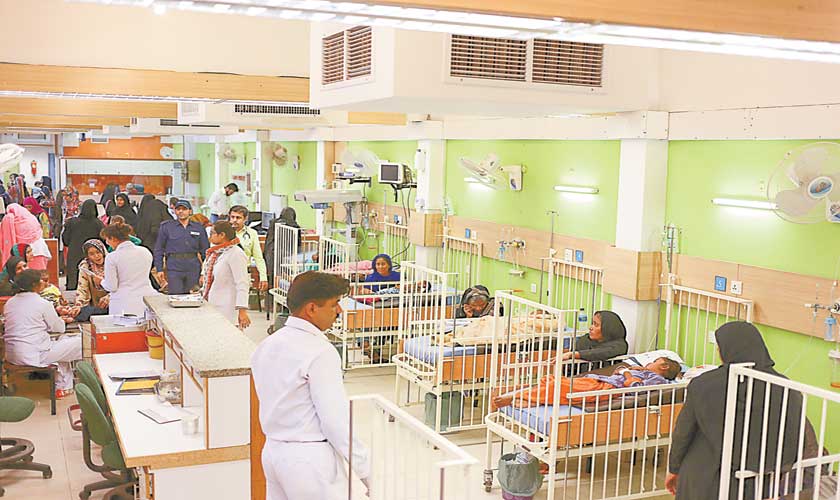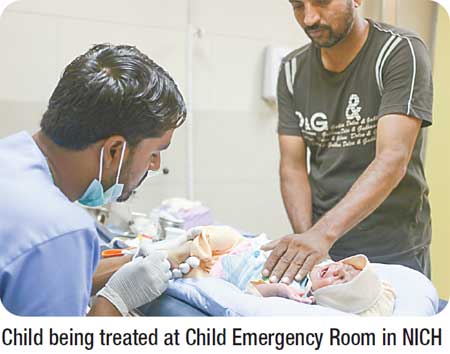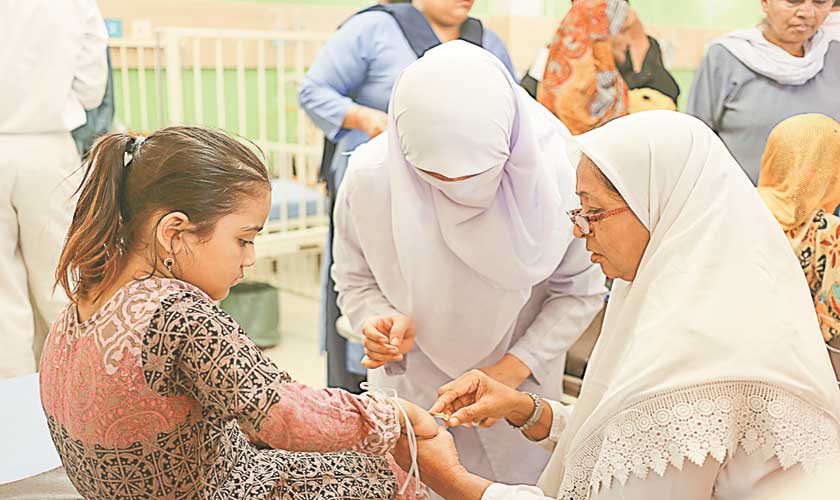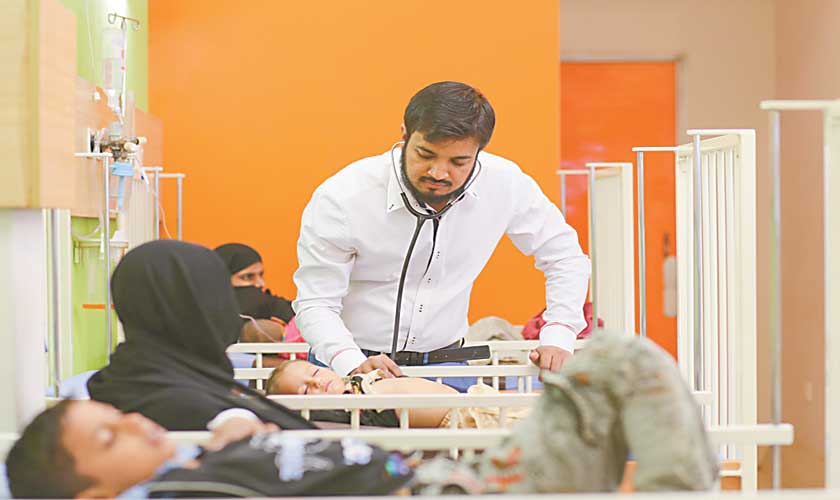Foundation that runs 16 centres in Karachi where children are given first- aid and then transferred to paediatric emergency care at the Civil Hospital (CHK), and National Institute of Child Health (NICH) for further treatment...
This week You! takes a look at ChildLife
Foundation that runs 16 centres in Karachi where children are given first- aid and then transferred to paediatric emergency care at the Civil Hospital (CHK), and National Institute of Child Health (NICH) for further treatment...
It is said; once you give birth to a child that is the day you realize there is someone in the world that you love more than yourself. Now imagine losing that someone due to the lack of proper healthcare system. There are many cases where parents lose their children all because of the negligence of quacks. Usually, infants and newborns risk losing their lives due to the non-availability of quality emergency treatment or lack of knowledge among parents, especially mothers, who resort to traditional remedies further aggravating the condition of the ill child.
However, there are foundations like CLF that are striving hard to save lives of infants.

CLF’s Children’s Emergency Unit in Civil Hospital, Karachi
Samita, brought her six days old child to ChildLife Emergency Room believing her baby would survive. She sat there with her eyes closed and lips murmuring as she prayed for her child’s fast recovery. The baby was suffering from severe respiratory issues and high fever, so the journey from Manghopir to NICH, Karachi was by no means comfortable. In the past, she had lost two of her children due to medical negligence of the doctors in their neighbourhood. But this time they did not waste any time and rushed to the facility as soon as they found out the child was not well.
The family did not go to see the general physician in the locality or contact the compounder or paramedics living in the vicinity. The reason simply was that they knew they could get everything ranging from emergency care, diagnosis and medication to post-treatment care under one roof and that also totally free of cost. Their destination was the child emergency centre at NICH managed by a voluntary trust ChildLife Foundation (CLF) under a unique public private partnership (PPP) model.
After examining Samita’s baby, doctors diagnosed severe respiratory distress and jaundice. The child was instantly put on ventilator and phototherapy after her bilirubin was tested to be very high. Within a couple of days the child was totally fine and fit to go home. Had the child not been taken for emergency treatment in time she would also have faced the fate of her siblings who had expired earlier.
Another case is of Sheherbano who was born prematurely as her mother suffered from hypertension. The girl was born at home and was brought to the CLF Emergency Room when she was a day old. On examination, the doctors declared that she was suffering from birth trauma with a fractured arm, dislocated shoulder and respiratory distress. On inquiry, it was discovered that she was pulled out from her mother’s womb by her hand. Thanks to the doctors Sheherbano was treated and now leads a normal healthy life!
The statistics show...
It is no secret that infectious diseases and preventable conditions claim the lives of millions of children in low-income countries like ours.
According to the WHO, approximately 5.9 million children under the age of five died in 2015 - an appalling 16,000 children every day. The leading causes of death among children under age five are preterm birth complications, pneumonia, diarrhoea, birth asphyxia and malaria. About half of these deaths occurred only in five countries - China, India, Nigeria, Congo and Pakistan - and most of these deaths can be prevented by simple, low-cost interventions.
In Pakistan, there were 245,000 neonatal deaths in 2015. The country has the third highest infant mortality rate in the world with pneumonia alone killing 92,000 children every year, according to the Pakistan Paediatric Association.
The birth of CLF:
Taking a sick child to a hospital or a clinic is a task in itself. Logistics, finances and lack of awareness work against the patient and most children end up being treated by quacks or unqualified doctors in their area.
It was because of lack of child healthcare in our country that ChildLife Foundation (CLF) was founded in 2010 by affluent Pakistanis including big names in the world of business, globally renowned medical professionals and accomplished professionals. Later on, the CLF joined hands with the Government of Sindh to take over paediatric emergency care at the Civil Hospital (CHK), and National Institute of Child Health (NICH) in Karachi.
“Before 2010, only 15 per cent sick children visiting the emergencies of Karachi’s two big hospitals - Civil Hospital and Jinnah Postgraduate Medical College hospital - were able to survive. Now this ratio has remarkably improved to 95 per cent survival rate. Children from Karachi, interior Sindh and Balochistan provinces visit these emergencies and are treated in the best possible manner by highly competent and professional staff,” shares Hasnain Akbar, manager communications at CLF.
“The organization spends nearly Rs 350 million annually on treating children. In addition to running child emergencies at these two hospitals, the CLF runs 16 centres where children are given immediate first- aid and then transferred to these two emergencies for further treatment. As soon as a family with an ill child arrives, the treatment begins there and then. Even the documentation process is carried out once the child’s situation stabilizes and there is no cash counter at all,” explains Akbar.
“The CLF has treated more than a million children since March 2011 to 2016 and the daily expense on treatment of a child comes around Rs 700. In developed countries, a new born baby is kept in the emergency for up to four hours. In Pakistan, this duration is from 10 to 12 hours. However, the CLF with its efforts has been able to bring down this duration to four and a half hours,” he adds.
ChildLife Foundation’s mandate is never to return a patient even if the presenting complaint is minor. “CLF holds a surplus stock of 15-20 days in pharmacy as a buffer in case of poor law and order conditions or any unforeseen situation in the city. Life-saving medicines, even the very expensive ones, are delivered free of cost to patients. Similarly, all medicines, including the hard-to-find rabies immunoglobin, are stocked in a temperature-controlled environment according to international standards,” says Akbar.
Dr. Ahson Rabbani, CEO, CLF shares, “The foundation currently manages two emergency centres in government hospitals and by adding third Hospital in Korangi our total number would go to about half a million children treated every year. Every doctor, every nurse and every paramedic working in our emergency rooms is certified in Basic Life Support. We have the first ever response units in emergency rooms in public sector hospitals in Pakistan.
Introducing telemedicine:
CLF has also introduced the concept of telemedicine. Dr. Hubba Attique, Senior Consultant Paediatric Emergency, In Charge of Telemedicine at CLF explains, “Telemedicine is new in Pakistan, but CLF is making full use of the technology in training, guidance and monitoring of its doctors and paramedics. We have installed cameras here for two purposes. One, we monitor quality of services offered by our doctors and staff and two, we support them live in their decision-making. It has proved to be very beneficial for patients by cutting down time of service delivery and the element of convenience is an added value for them.”

Iqbal Adamjee, Chairman, CLF says “Our work is far from done. The aim is to increase the emergency centres and clinics we operate as well as to expand the preventive health program. We will continue to work with the government to expand the function and capacity of the emergency centres at NICH and Civil Hospital as well as bring more government-run emergency centres under our umbrella.”
Doctor’s desk
According to Dr. Irfan Habib, paediatrician and head of clinical affairs at CLF, dehydration is one of the few emergencies in which a child needs immediate help. “A mother can detect by looking at the child’s body condition that a child should be rushed to the hospital, especially if the family due to lack of awareness or any other reason fails to give ORS. The symptoms of dehydration can vary from mild, moderate to severe. However, the symptoms that mothers should look for include: increase in thirst; a dry tongue; generalized body weakness; feeling of dizziness, fainting, unconscious; increase in heart rate confused/lethargic; irritability; lack of sweat excretion; and a reduced urine output.”

A long way to go
“Failure of health services at emergencies at Civil Hospital led to the idea of ChildLife Foundation formation. We have established quality services in Civil Hospital and National Institute Child Health. All our activities are funded by people of Karachi. Nearly 80 per cent of funds are generated here. We have completely transformed childcare facilities in these hospitals by providing free of cost service and medicines,” explains Dr. Naseeruddin Mehmood, child specialist and founding trustee of CLF.
“However, this is just the start and there is a long way to go as far as health care improvements in Pakistan are concerned,” he concludes.